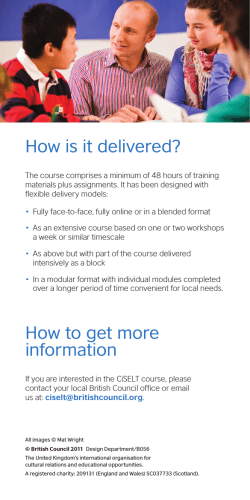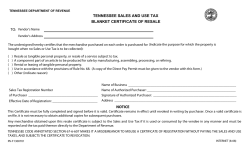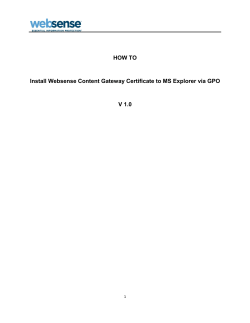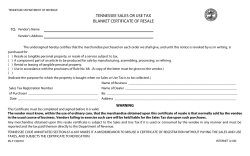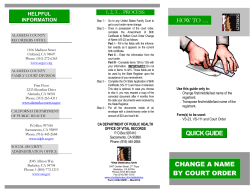
Document 250466
Resource & Research Guides Vol. 2 #7 2011 Why should we teach Science in Transition Year? Sarah Hayes Background to the Transition Year The Transition Year Programme (TYP) is a one year optional programme offered to students in their fourth year of second level education, between the junior and senior cycles. Schools are not obliged to offer the programme, and if they do, pupils are not required to take it. Table 1, below, indicates the current trends in the numbers of pupils taking the programme, and schools offering it. Table 1: Percentages of schools and pupils offering the Transition Year The core layer includes subjects such as English, Irish, Mathematics, Physical Education and Religion. Science may be offered in either the subject sampling layer with other subjects such as Spanish, Business Studies etc or as a modular programme in the TY specific module and subject layer. The calendar layer is designed for once off events, such as field trips, work experience, outreach and visiting speakers. Unfortunately, as in junior cycle and senior cycle, science is not a core subject in the TYP, and it is entirely up to the school whether or not to offer it. Benefits of the Transition Year How schools offer the TYP varies from school to school, with each school having the autonomy to design and implement its own curriculum in line with the Transition Year Guidelines. (Department of Education and Science 1993) Figure 1 illustrates the ‘onion model’, which indicates the main areas of the Transition Year (TY) course that schools should offer. Figure 1: The Transition Year Curriculum (Transition Year Second Level Support Service 2007) The four areas of the TYP are the core subject layer, the subject sampling layer, the TY specific module and subject layer and the calendar – ‘once off’ layer. Figure 2: The benefits of the Transition Year. Several national studies of schools by the Economic and Social Research Institute (ESRI) have looked at the Transition Year. One of the key studies is that of The Transition Year: An Assessment by Smyth and Hannon (2004), who found that TY participants gain higher grades in their Leaving Certificate than non-participants, the average difference between the two being just over two grade points per subject. (A grade point in this study involved scoring each examination grade, i.e. A1 – F from 0 to 28 and averaging the total scores over the number of examination subjects taken). The research showed on average that students who took TY were more likely to get higher grades in their Leaving Certificate. These 1 © Sarah Hayes & NCE-MSTL 2011 Resource & Research Guides Vol. 2 #7 2011 findings are in line with those of a longitudinal study carried out by Millar and Kelly (1999), for the National Council for Curriculum and Assessment (NCCA), on 1994 Junior Certificate candidates who took the Leaving Certificate in 1997. This a valuable source of information on the benefits of the TYP. Those who took TY also scored higher Leaving Certificate points than those of their peers who did not take TY, with a difference of 46 CAO (Central Applications Office) points between the two groups. Smyth et al. (2004, p.187) noted that it would appear “that taking part in Transition Year has an important influence on young people’s subsequent route through the senior cycle.” The NCCA report noted that students who took the TYP were more educationally adventurous than those who did not; they were more likely to retain subjects at a higher level, and were also more likely to take up new subjects in fifth year. Following on from these findings on TY students being more educationally adventurous, Smyth et al. (2004) noted that these students were also more likely to go on into higher education. The TYP may also have a positive impact on students in disadvantaged schools, with those who have taken TY doing significantly better than expected and better than those in similar schools who did not take the programme, particularly when viewed in the context of prior results. (Smyth et al. 2004, pp. 222-223) Another, perhaps less examined, yet nonetheless important benefit of TY, is the opportunity for the students’ psychosocial development, which can be seen in Figure 3. Figure 3: Erikson’s psychosocial stage at T.Y. Erikson proposed 8 stages of psychosocial development; the stage that best relates to adolescence and students in Transition Year is that of Identity versus Role/Identity Confusion. The TY occurs at a time in student’s life when they begin to “question beliefs, attitudes and value systems that they had internalized previously without much thought.” (Good and Brophy, 1990, p.101). TY, with its relaxed curriculum and emphasis on the emotional development of the student, is an opportune time for adolescents to develop their own identity. The adolescent and their peers face working together in groups in a way which they may have never experienced before, essentially becoming a part of a unique TY community within the school. The year also offers an opportunity for students to become a part of the senior cycle, being treated more like adults by school staff, thus improving future classroom relationships. “Transition Year was seen as facilitating improved relations between teachers and students” (Smyth et al., 2004, p.166). Jeffers notes that the TYP has shown that Education for Maturity is something that it does very well, and it was also noted that “A consistent thread through the data from all informants is that students are more mature as a result of the TY experience” (2002, p.2). Perhaps this is because students take note of TY activities as they involve “learning beyond conventional classrooms”. The students “value classes in which their opinions are sought and listened to.” (Jeffers 2007). Why do Science in the Transition Year? “Transition Year is an opportunity for pupils to become familiar with a broad range of Science activities. Pupils should be encouraged to study areas of Science not heretofore encountered.” (Department of Education and Science, 1993, p 10.). TY is a year with no prescribed syllabus and no curriculum other than some broad educational guidelines. This freedom offers teachers the opportunity to contextualize science in terms of its role in students’ life and society. TY science sampling offers an opportunity for students to make informed decisions about their subject choice at senior cycle. The Association of Secondary Teachers 2 © Sarah Hayes & NCE-MSTL 2011 Resource & Research Guides Vol. 2 #7 2011 in Ireland believe that TY should aim to develop students’ “scientific skills and to promote a greater awareness of the role of science in their lives.” (A.S.T.I. 1991, p.16). Schools can choose what they offer as a Science taster programme. Generally TY schools either offer a taster course in one or more of the Sciences offered at senior cycle or they offer a general science course, similar to the Junior Certificate programme (Hayes, 2009a). The most common taster courses being offered are in Physics, Chemistry and Biology. The ‘narrow’ scope of the science syllabi at both Junior and Leaving Certificate leaves little opportunity for teachers to contextualize science and explore the role of science in our everyday lives and in society (Smith and Matthews, 2000). The TY can be viewed as a unique opportunity to really bring science alive and open students’ minds to the real world applications of the subject, rather than the limited scope of traditional school science. Studies have shown that it is students’ attitudes to school science that declines NOT their attitudes towards REAL science and the usefulness of science (Osbourne cited in Barmby et al., 2008, p.1078). In the main, students view the work of a scientist as “difficult, complicated and boring, as well as poorly paid” (Department of Education and Science, 2002, p.iv). Traditional school science frequently fails to tackle current and relevant issues (Osborne, 2002; Childs et al., 2010). Science needs to be appreciated for the intrinsic pleasure it can offer an inquiring mind and it should be taught in this fashion. TY is a unique opportunity to do just that, with the freedom and autonomy it offers to schools and teachers. This allows students who might have otherwise not have appreciated science, to learn to become excited by it and to love it. A good science sampling programme in TY can lay the foundations for a rich and rewarding scientific career for many students, a lifelong interest in the subject and help develop a level of scientific literacy. Scientists read for 553 hours per year and 58% of scientists’ time is spent working on/in communication (Osborne, 2010). Students at second level often do not realise that communication skills are necessary for science. Skills such as team work and good communication skills are vital to a fruitful career in science. School text books present science as a truth, with little or no argumentative text (Penney et al., 2003). Science must be discussed, argued and discussed further. It is through this process of peer review and discussion that the boundaries of science are challenged and that we progress further in the field. Often both the public and our students fail to see the relevance of science research, and hold incorrect views. http://www.cartoonistgroup.com/store/add.php?iid=13 389 In his report on the Relevance of Science Education (ROSE) project, in relation to Ireland, Matthews (2007) noted the following: • Students’ highest degree of interest is in themes involving health, sex, genetics, natural disasters and the origin of life, space and the universe. • Students are convinced of the importance of science and technology for society. • Students do not believe science is ‘helping the poor’ or that it will ‘eradicate poverty and famine in the world’. • Students want to make use of their individual talents and seek personal involvement and some degree of autonomy in their future careers. • Students value personal and social relations as much, perhaps more, than material rewards in their careers. • The great majority of students do not want ‘to become a scientist’ or ‘to get a job in technology’. 3 © Sarah Hayes & NCE-MSTL 2011 Resource & Research Guides Vol. 2 #7 2011 • Girls’ and boys’ preferences for careers related to science were dominated by activities that had a biological/ medical/ health theme. • Understanding of key areas in science • Understanding of the applications of science • Awareness of careers in science References: The ROSE study, which was completed in November 2003 by 688 TY or fifth year students, is of particular interest to TY science teachers. It offers a rare glimpse into the attitudes of TY students towards science. The study was designed to gather information about students’ opinions and attitudes towards schools science and science-related issues. The ROSE study notes that science needs to be relevant for the learner. They note that “if one wants to attract more young people into science, it is essential to engage them with the human context of science” (Matthews, 2007, p.87). It also appears the there is a clear difference between student interest and motivation. While students may be interested, as “even the most mundane of practical tasks” will readily awaken a student’s interest, it is much more difficult to convert this into long term motivation (ibid). There appears to be a contradiction in terms, in that Science, a subject aimed at making the world clearer and developing awareness is considered by many students to be too abstract and complicated. The TY is an opportunity for both teachers and pupils alike to move away from traditional school science and to explore what a career in science would have to offer them through a context based approach. For many this may not lead to the further pursuit of science, but one can hope for a sound general understanding of the subject and its importance in many applications, both in industry and in everyday life. This is the basis of scientific literacy. There are many resources available which utilise the teaching of context-based science through an inquiry-based approach, as discussed in previous research and resource guides (Hayes, 2009b; Hayes, 2010) Ideally a TY science programme should develop the following skills in the students: • Scientific literacy • Communication skills • A.S.T.I., (1991) ‘The Transition Year Option A Teacher’s Handbook’, A.S.T.I.: Dublin. • Barmby, P., Kind, P.M., Jones, K. (2008) 'Examining Changing Attitudes in Secondary School Science', International Journal of Science Education, 30(8), 1075-1093. • Childs, P. E., Hayes, S., Lynch, J. and Sheehan, M. (2010) ‘Developing scientific literacy: TY science and science scrapbooks’ in Eilks, I. and Ralle, B. eds., ‘Contemporary Science Education – Implications from Science Education Research about Orientations, Strategies and Assessment’, Bremen, 27 -29 May, Aachen: Shaker. • Department of Education and Science, (1993) Transition Year Guidelines for Schools, Dublin: Department of Education and Science. • Department of Education and Science, (2002) Report of the Task Force on the Physical Sciences, Dublin: Statement in conjunction with the National Council for Curriculum and Assessment Department of Science and Education. • Good. T. L. and Brophy, J. E. (1990) Educational Psychology: A Realistic Approach, 4th ed., New York: Longman. • Hayes, S. (2009a) ‘A critical examination of the place of science in the Irish Transition Year’, unpublished thesis (Transfer from M.Sc. to Ph.D.), University of Limerick • Hayes, S. (2009b) ‘Transition Year Science Resources’, NCEMSTL Research and Resource Guides, 1 (2) • Hayes, S. (2010) ‘Transition Year Science Resources: Resources from the U.K.’, NCE-MSTL Research and Resource Guides, 2 (8) • Jeffers, G. (2002) 'Transition Year Programme and Educational Disadvantage', Irish Educational Studies, 21(2), 47 — 64. • Jeffers, G. (2007) Attitudes to Transition Year Summary of a Report to the Department of Education and Science, Department of Education and Science. • Matthews, P. (2007) The Relevance of Science Education in Ireland, Dublin: The Royal Irish Academy. • Millar, D. and Kelly, D (1999) From Junior to Leaving Certificate, A Longitudinal Study of 1994 Junior Certificate Candidates who took the Leaving Certificate Examination in 1997, Final Report, Dublin: ERC/NCCA. • Osborne, J. (2002) 'Science Without Literacy: A ship without a sail?', Cambridge Journal of Education, 32: 2, 203 — 218 • Osborne, J. (2010) ‘Science without Literacy: A Ship without a Sail?’ presented at Science and Mathematics Education Conference (SMEC10), 16 September – 17 September • Penney, K., Norris, S. P., Phillips, L. M., & Clark, G. (2003) ‘The anatomy of junior high school science textbooks: an analysis of textual characteristics and a comparison to media reports of science.’ Canadian Journal of Science, Mathematics and Technology Education, 3(4), 415–436. • Smith, G., and Matthews, P. (2000) 'Science, technology and society in transition year: A pilot study', Irish Educational Studies, 19(1), 107-119. • Smyth, E., Byrne, D., and Hannon, C. (2004) The Transition Year Programme: An Assessment, 1st. ed., Ireland: The Liffey Press. • Transition Year Second Level Support Service, (2007) ‘Transition Year Curriculum’, [online], available: http://ty.slss.ie/curriculum.html [accessed 21 Oct 2008] Ms Sarah Hayes Project Officer for Teaching and Learning -Physical Sciences NCE-MSTL E-Mail: [email protected] 4 © Sarah Hayes & NCE-MSTL 2011
© Copyright 2025


